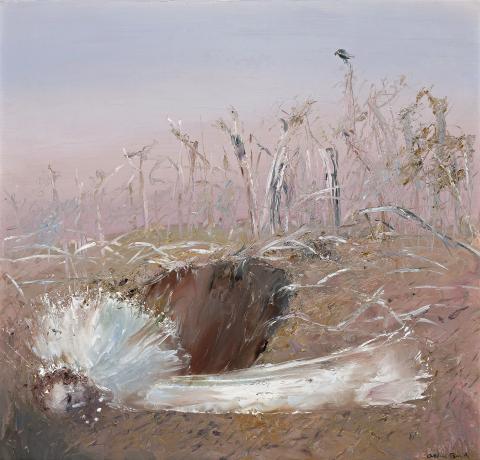BRIDE IN LANDSCAPE, c.1967
ARTHUR BOYD
oil on canvas
106.5 x 112.0 cm
signed lower right: Arthur Boyd
Private collection
Savill Galleries, Sydney (label attached verso)
Private collection, Perth
Arthur Boyd, Philip Bacon Galleries, Brisbane, 14 May – 7 June 1991, cat. 1 (illus. front cover)
Arthur Boyd: Five Decades, Savill Galleries, Sydney, 19 September – 23 October 1991, cat. 8 (illus. and back cover)
Transformed from her former wide-eyed and full-bodied presence, Arthur Boyd’s symbolic bride is presented here, in Bride in Landscape, c.1967 as an ethereal echo of her previous embodiments. Bridging a stylistic and thematic gap between two chapters of Boyd’s oeuvre, this work features the painter’s recurrent bride in a desolate landscape observed only by a single black crow. Alone, his protagonist now adopts the trope of a ‘figure in landscape’ that Boyd would use throughout the 1960s and 1970s, underpinned by Biblical and mythological narratives. Inspired by the discovery of European masterpieces following his migration to London in 1959, the artist began a series of inventive depictions of his bride, including Bride with Lover (Bride Turning into a Windmill), 1960, and Nude Turning into a Dragonfly, 1961. Franz Philipp in his 1967 monograph described these paintings as ‘forming an epilogue of mood rather than of narrative sequence, [they] call the fleeting apparitions of the phantom bride back into a land of timbered gullies and nocturnal ponds’.1
Following the critical acclaim of the series ‘Love, Marriage and Death of a Half-Caste’, commonly known as the Bride series, depicting a poetic narrative of an ill-fated relationship, Boyd reused his former protagonist in later works as a means of further exploring psychological themes. When the initial series was presented by the artist in an exhibition at Australian Galleries in 1958, he labelled them as ‘Allegorical paintings’, partially masking the social commentary inherent in his subject matter, instead highlighting the exploration of universal themes of love, fear, and identity and alluding to thematic developments to come.
Revisiting the Bride series with whimsical variations throughout the 1960s, Boyd explored the existential limits of his leading lady. Continuing the constant physical and psychological transformations affecting her in his original series, this painting, Bride in Landscape, is an epilogue in which the bride is listless, exiled and almost formless in the physical absence of her departed lover. Painted concurrently with the artist’s Nebuchadnezzar series and featuring similar mise-en-scene and emblems, this bride is presented on the cusp of metamorphosis. She is loosely painted; the thin glazes of her white matrimonial regalia are physically permeated by the strong ochre colour of the central Australian earth. No longer floating in a Chagall-like manner, she is prostrated in the foreground of the landscape, becoming one with it. While the landscape that this bride inhabits is barren, its cavernous forms hint at underlying eroticism left over from Boyd’s original series.
Featuring the expressive brushstrokes of his later works, Bride in Landscape can be easily read as a portrait of the flawed hero, a painterly version of a theatrical soliloquy. The bride appears at once as herself but also as a tragic goddess of classical myths, such as the chaste Diana or a bathing Susannah. An example of pure artistic and poetic experimentation, Bride in Landscape is a psychological extension of Boyd’s famous series, seeking to illustrate less tangible themes of the vicissitudes of human emotion.
1. Philipp, F., Arthur Boyd, Thames and Hudson, London, 1967, p. 92
LUCIE REEVES-SMITH
